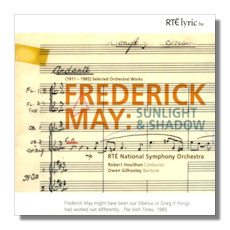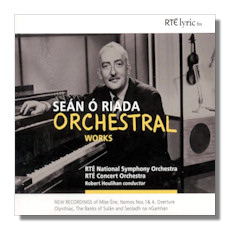
The Internet's Premier Classical Music Source
Related Links
- Latest Reviews
- More Reviews
-
By Composer
-
Collections
DVD & Blu-ray
Books
Concert Reviews
Articles/Interviews
Software
Audio
Search Amazon
Recommended Links
Site News
 CD Review
CD Review
20th-Century Irish Composers

Frederick May
Orchestral Works
- Sunlight & Shadow
- Scherzo
- Spring Nocturne
- Suite of Irish Airs
- Songs from Prison *
* Owen Gilhooley, baritone
RTÉ National Symphony Orchestra/Robert Houlihan
RTÉ Lyric FM CD135 70:45


Seán Ó Riada
Orchestral Works
- Overture Olynthiac
- The Banks of Sulán
- Hercules Dux Ferrariae: Nomos #1 for String Orchestra
- Seoladh na nGamhan (The Herding of the Calves)
- Nomos #4 for Piano and Orchestra 1
- Suite "Mise Éire" a
- Mná na hÉireann 2,b
1 Cathal Breslin, piano
2 Seá Ó Sé, tenor
RTÉ National Symphony Orchestra/Robert Houlihan
a RTÉ Concert Orchestra/Robert Houlihan
b RTÉ Concert Orchestra/Proinnsias Ó Duinn
RTÉ Lyric FM CD136 67:46
Summary for the Busy Executive: Always well-made, often inspired.
Although Irish folk music has inspired non-Irish composers, I ask whether Irish composers embarked on a program to produce an Irish national music similar to English composers in the Twentieth Century. Knowing nothing about Irish classical music except for those composers who made their careers outside of Ireland, I've acquired a series of discs from RTÉ, the Irish broadcasting service. I will review only those discs that I like and that are easily available in the U.S.
Considered a fellow of promise, Frederick May studied with Ralph Vaughan Williams and Gordon Jacob, among others. He received a grant to study with Alban Berg in Vienna, but Berg died before May could get there. Berg pupil Egon Wellesz took him on. However, a host of problems afflicted May, including tinnitus, alcoholism, and mental illness, for which he was hospitalized. He completed only six orchestral works, a highly-regarded string quartet, plus some fugitive pieces and theater music and in his last decades wrote nothing at all. So this CD has most of his major output.
Sunshine and Shadow, May's final completed work, appeared in 1955 (May died in 1985). The score owes a lot to Gustav Holst and Vaughan Williams – I'd say more Holst than VW – but it also has a lyricism that belongs to neither of the older men. It reminds me of the tunes to Thomas Moore's Irish Melodies.
May wrote the Scherzo (1933) as the culmination of his studies at the Royal College of Music. It has some of the intensity of Holst's "Mars" from The Planets as well as the regard of those who wrangled the opportunity for May to study in Vienna.
In the 1937 Spring Nocturne, we see May breaking free from his models. An exploratory work, at times it anticipates some of what Vaughan Williams was doing in the Forties. It's a little loose structurally, but May's commitment to try something new far outweighs the defects.
Commissioned by Irish broadcasting, the Suite of Irish Airs doesn't pretend to more than its title. May orchestrates traditional Irish tunes, and quite well. The score lacks the wit of similar works by Vaughan Williams and Holst. On the other hand, it has many poetic moments – for example, a passage for oboe, horn, and timpani in the first movement.
In 1941, May finished his most ambitious score, Songs from Prison, which sets poetry by Ernst Toller, a German Jewish Socialist writer who had been exiled and who finally settled in New York. He committed suicide in 1939 when he heard that the Nazis had sent his brother and sister to concentration camps. It concerns a camp prisoner consoled by the observation of a pair of swallows. The guards see this and kill the swallows, but the work ends with the prisoner's hope for freedom. May set the German original but had it translated to English by Nigel Heseltine, son of the composer Peter Warlock, and that's the version performed here. The music seems to combine Frederick Delius and the Gustav Mahler of "Der Abschied." Unfortunately, while full of inventive orchestral sounds, it's just not all that memorable, as the Mahler surely is. It never really grabs you and takes off.
Born John Reidy, Seán Ó Riada, a brilliant polymath, became intensely involved in traditional Irish culture. He formed the traditional music group Ceoltóiri Chualann, several of whose members went on to form The Chieftains. However, he also knew classic Latin and Greek literature in the original languages as well as Modern European art, music, and literature, and studied classical composition with Aloys Fleischmann. He amassed a catalogue larger than May's, but he died young at 40 of cirrhosis.
His early death dealt a real blow to Irish culture. Had he lived, he, if anyone, could have created a Modern school of Irish classical music. He wrote in an incisive, original voice, without the baggage of Late Romanticism. If I had to, I'd compare him to Béla Bartók, although you'd never mistake one for the other. I find common threads in their fierce grasp of structure, their lean writing, and their rhythmic vigor and drive.
The Overture Olynthiac (1955) refers to either one of the many mortal sons of Zeus or the northeastern Greek city at one time a considerable power in the region. According to the liner notes, the overture is Ó Riada's first major work, and it bowled me over from its opening measures. From an opening of ringing brass and booming timpani, it shows a composer wielding the freedom to do not only whatever he wants, but whatever the piece demands at a certain moment. Will and necessity fuse. The lyrical sections quote no Irish tunes but evoke the early times, even before the bodhrán.
The Banks of Sulán (1956) stems pretty obviously from British musical pastoralism, but with important differences. At its best – say, Vaughan Williams's Third Symphony – we generally get the impersonal serenity of nature. Ó Riada's banks flow with sorrow and trouble. In the first place, we get far more dissonance than we'd expect from a British pastoral score in the first and last sections, with the dissonance further ramped up in the middle. What sounds like the fragment of an ancient Irish folk tune, although it could very well be Ó Riada's own, rides a troubled surface. Serenity lies a world away.
"Hercules Dux Ferrariae" is a text from the Renaissance composer Josquin des Prez, the title of a mass he dedicated to his patron, the Duke of Ferrara. Not only that, he derived the primary musical theme from the text with a technique he invented later called soggetto cavato dale vocali di queste parole (carved out of the vowels of these words), by which the vowels of the text syllables translate into notes according to an older method invented to help singers read music. The pitches were: ut re mi fa so la. Thus, "Hercules Dux Ferrariae" translates into: "Her"=re, "cu"=ut, "les"=re, "Dux"=ut, "Fer"=re, "ra"=fa, "ri"=mi, "ae"=re, or in modern practice D C D C D F E D (key of C). "Nomos" is Greek for "law." Thus, we would expect Nomos #1 (1957) to adhere to strict compositional procedures, and the piece doesn't disappoint. Ó Riada not only uses the "Hercules" motif (or the latter part of it) but throws in two 12-note rows and the "learnéd" forms of canon, passacaglia, and fugue.
Ó Riada planned to write six more, but of the remainder completed only #2 (a setting of Sophocles), #4, and #7. Frankly, Nomos #1's a piece that sounds as if nobody in the British Isles had written it. The liner notes try to make a case for its Irishness, but it has more in common with the European continent than with other Irish or British music (even Britten) at the time. Again, it reminds me of Bartók. The string textures sting and wail. Despite the use of tone-rows, it remains a tonal piece, mainly due to Ó Riada's acute harmonic sense. He usually puts his rows against a strongly tonal base. Overall, the work flashes with wit, tragedy, and dark humors – if you will, musical portraits of Hamlet and Mercutio.
Seoladh na nGamhan (1959) originally had the word "Pastorale" in its title – yet another ode to the country Irish. It adheres a little more closely than The Banks of Sulán to the Vaughan Williams model, although here and there weird interludes pop up. Nevertheless, the score hangs together beautifully.
A concertino in two movements (slow-fast) for piano and orchestra, Nomos #4 (1958), like the earlier Nomos, uses a tone row without getting into atonality, mainly due to the composer's ability to create a twelve-note row with tonal implications. Indeed, it sounds as much modal as chromatic. It opens with the row ringing out on the tubular bells. The first movement veers between stern majesty and regret, in an idiom akin to the Bartók first piano concerto. Of many remarkable passages, one of the most enigmatic is one that functions as a cadenza. Unusually, it's one-hand pianism, one note at a time (no chords), rather than a display of virtuosity. However, it performs the primary architectural function of a cadenza by suspending the forward progress of the movement. About half of the quick finale is taken up with an exuberant dance between the piano soloist and the percussion section. Ó Riada gets both drive and delicate cross rhythms and color-shifts from the percussion. Then we have a repeat of the very opening of the piece when the tubular bells, this time accompanied by the piano, chiming out the row. The orchestra enters and the music turns into a driven jig almost to the end, where we encounter something like a false cadenza – one beat for the soloist followed by rests, before the movement takes up where it left off. However, with each of these, the music approaches pianissimo until it finally just dribbles away. A magnificent work of concentrated power.
Ó Riada's 1959 score to the documentary Mise Éire (I am Ireland, also the title of a poem by the rebel leader martyr Pádraic Pearse) raised awareness of his place in the forefront of Irish music. The film concerns the Easter Rising of 1916 and its aftermath. Ó Riada arranges rebel songs, some going back several centuries, with taste and skill. As a film score, it admirably serves its function.
Ó Riada increasingly became drawn to traditional music and folkways. As part of that journey, he arranged the song "Mna na hÉireann" (women of Ireland) for piano and singer. We hear it in an arrangement for singer and orchestra by Noel Kellehan. The vocalist is Sean Ó Sé, the composer's favorite singer, according to the liner notes. I mean no disrespect when I describe him as the quintessential Irish tenor, with a bright, nasal sound.
The performances all honor Ó Riada's music and the sound is quite good. They handle the thorny and the smooth with equal skill. The Ó Riada may be one of my 10 Best of the Year.
Copyright © 2014, Steve Schwartz


















